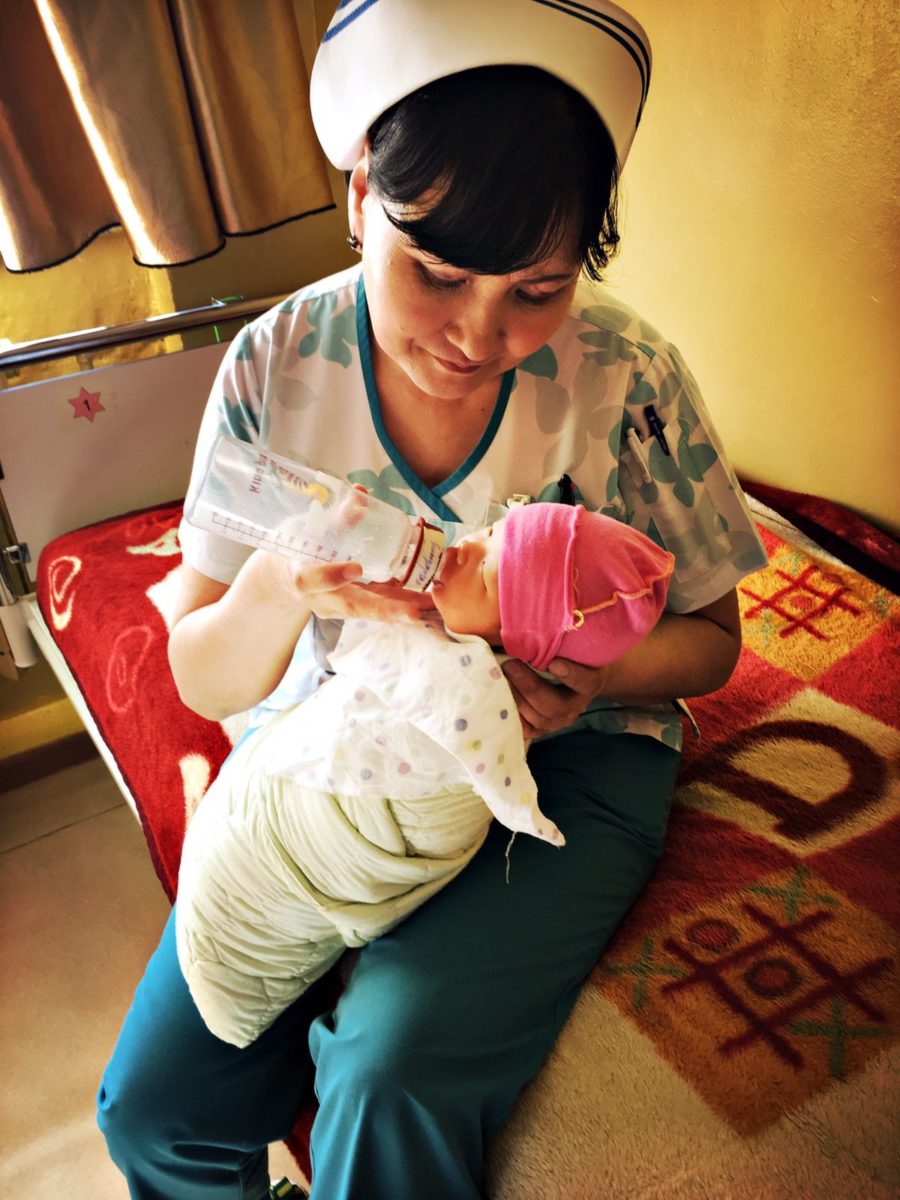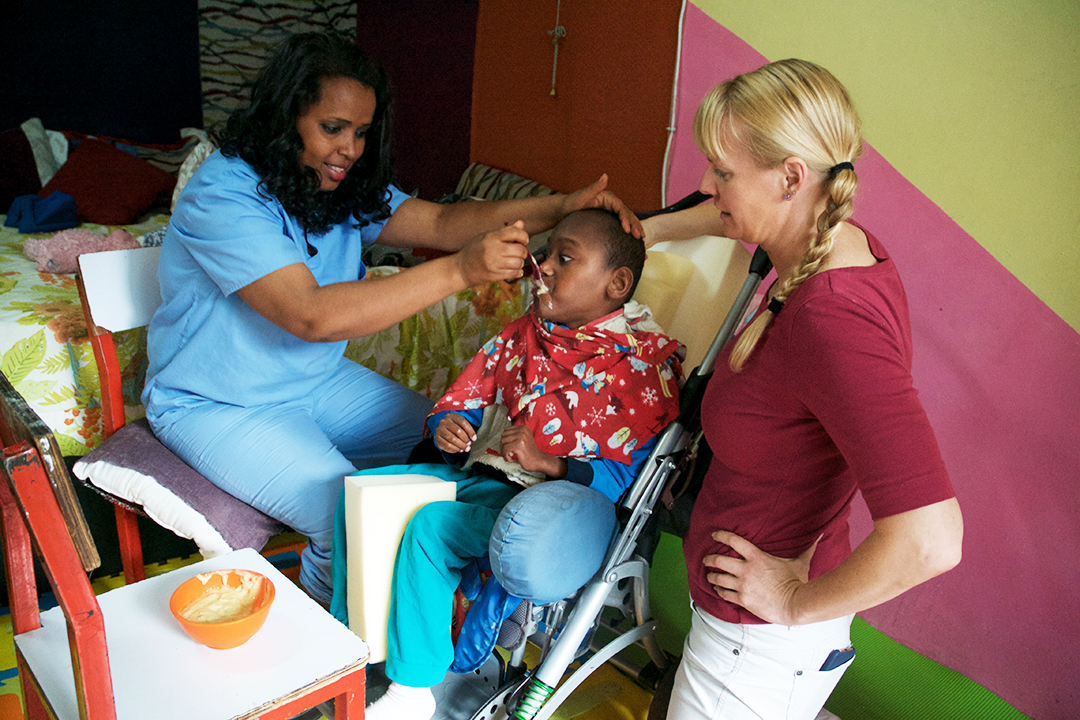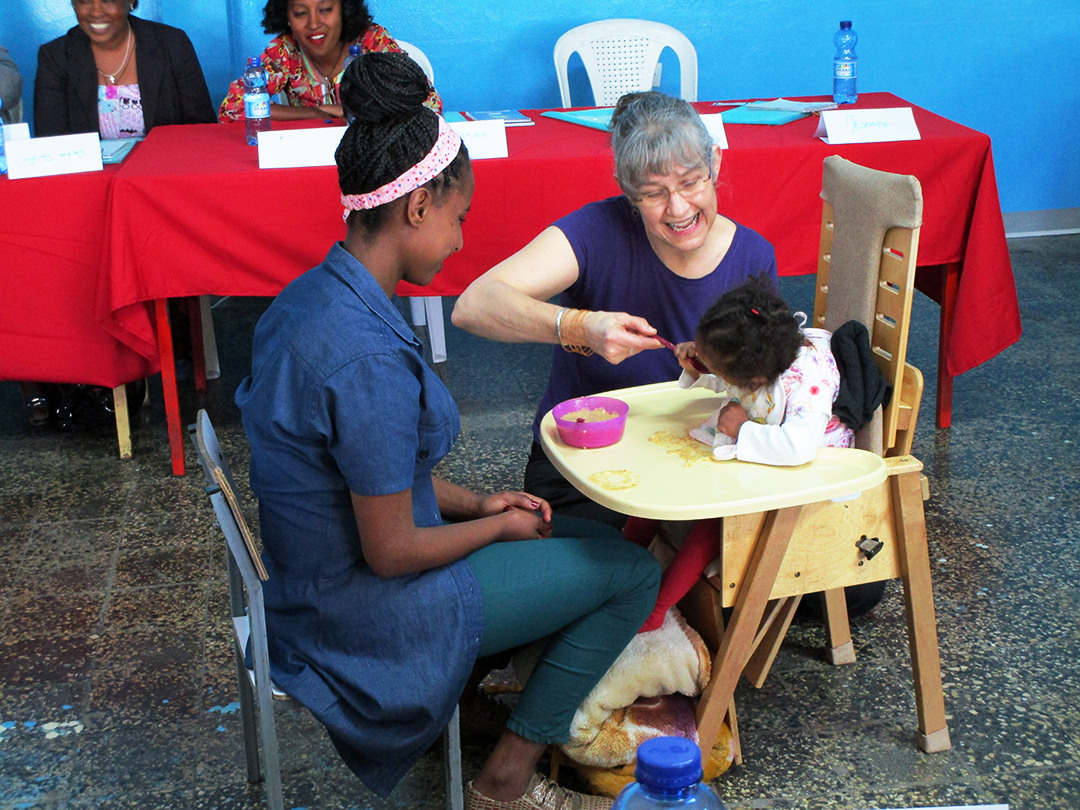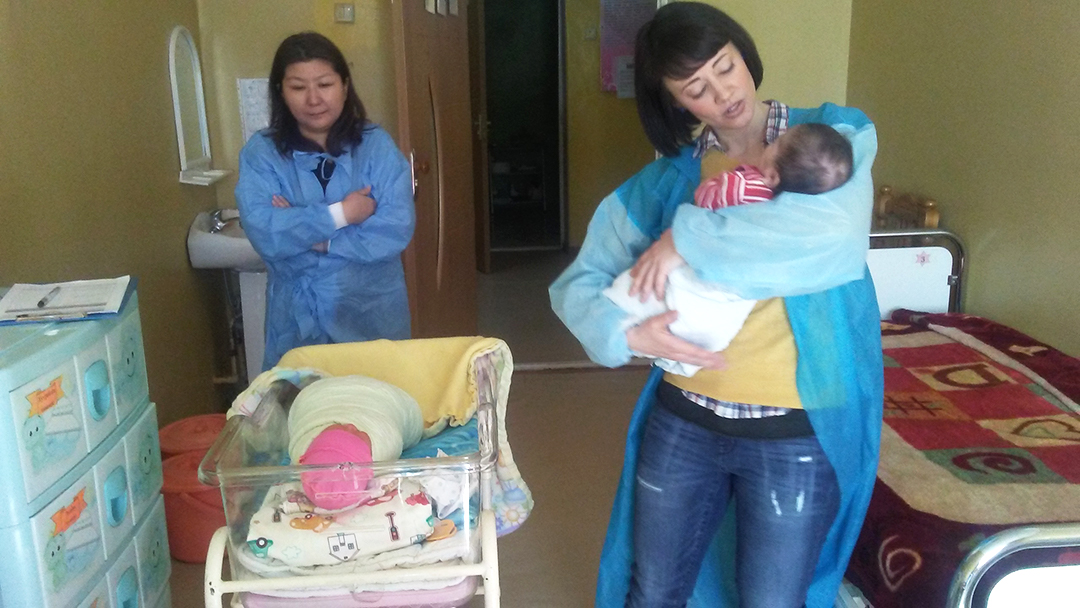Holt’s feeding specialists have traveled the world training caregivers in nutrition and feeding best practices — and sometimes, something as simple as a spoon can make all the difference.
Several months had passed since Holt’s child nutrition program team’s last trip to Ethiopia — to help lead a nutrition training at Sele Enat orphanage. And now, Rae Miller, an occupational therapist who specializes in feeding — a skill particularly helpful in her work with the child nutrition program — was there to evaluate how things were going. Already, rates of anemia had decreased and children looked healthier — and happier!
But still, one issue stood out: aspiration.
“[Aspiration] can lead to constantly feeling like you’re congested and you’re coughing,” she explains, saying that it is an extremely common occurrence — unavoidable, even — for children with special needs in institutional care. If improperly fed, she explains, children with special needs can easily aspirate. Not only is aspiration traumatic in the moment as a child struggles to breathe, but it can cause dangerous, chronic respiratory infections like pneumonia.
But in just six months, Rae felt amazed by the progress at Sele Enat.
“The caregivers were really doing a great job trying to support [the children’s] heads,” she says, explaining that with better support, children have better alignment, enabling them to swallow their food without choking on it. But as she continued to watch, she saw that some of the children with special needs — particularly those with cerebral palsy — were still struggling and choking as they ate, despite being in a more upright position.
Then, she saw why…
“They were using these huge spoons to feed the kids,” Rae says. She wondered why… “But then talking to people in Ethiopia,” she says, “[I learned] they don’t use spoons when they eat.” Instead, people in Ethiopia traditionally use their right hand to scoop up food with a piece of injera — a traditional spongy flatbread.
She realized, how could a caregiver who is not familiar with using a spoon herself possibly know the best way to use one to feed another person? Rae explained to the caregivers why some children were still struggling to swallow, and kindly offered some advice to keep them from choking.
“What if we try using a smaller spoon?” she suggested.
With this simple solution, aspiration immediately decreased.
Holt first began our child nutrition program in 2013 to address the feeding and nutritional needs of children in orphanage care. Using a holistic set of nutrition screening and feeding interventions that are scientifically designed for orphaned and vulnerable children, Holt’s child nutrition program has expanded through the years and now helps children thrive in China, Ethiopia, Haiti, India, Vietnam, Mongolia and the Philippines. Children in care in these countries now have regular nutrition and growth screenings, vitamin supplements and more nutrient-packed meals.
But even at orphanages with sufficient food, proper growth screenings and balanced, nourishing meals, our child nutrition program team began to observe that some children still struggled to grow and thrive as well as others. Often, they realized, the availability of food itself is not the problem — but rather, how children are being fed. As our child nutrition program team traveled to orphanages to conduct trainings, caregivers began sharing the challenges they face during mealtimes. With so many children to feed and a tight schedule to meet, mealtimes were tremendously difficult. Caregivers lacked basic-but-vital tools like child-sized spoons, cups and bowls — tools that would help them feed or teach self-feeding to children. Most at risk were children with special needs, especially those without the language skills to express their feelings.
Even at orphanages with sufficient food, proper growth screenings and balanced, nourishing meals, our child nutrition program team began to observe that some children still struggled to grow and thrive. Often, they realized, the availability of food itself is not the problem — but rather, how children are being fed.
To address these critical feeding needs, we recruited a team of feeding specialists — five accomplished women who are experts in the field of child development, mental health and feeding, and who are deeply passionate about the children in Holt’s programs. Each of them has volunteered her time and traveled to visit Holt’s programs abroad, and each has hundreds of experiences and stories of children whose lives have already changed.
In January 2018, these feeding specialists came together at Holt’s headquarters in Oregon to create a feeding manual for orphanage caregivers around the world.
Erin Kaui is one of our feeding specialists — a speech therapist whose specialty is working with children with feeding and swallowing issues.
“Training caregivers is so important because the caregiver works with so many kids,” Erin says. “Whatever you teach them is going to transfer from child to child to child. And the importance of [safe feeding practices] is that if you can teach [that when you] feed a child in a more upright position — rather than lying down — the kid feels that much safer.”

When a child cannot properly chew or swallow, and especially if they’re being fed flat on their back, mealtimes are scary — traumatic, even. Better feeding practices not only allows the child more of the nutrients their body needs, but it takes the fear out of eating.
When Rae Catt, an occupational therapist, visited the Philippines to share her expertise in infant feeding and bonding, the children touched her heart on a deep level. But so did the people who devote their lives to caring for them: the caregivers.
“There are [caregivers] there who live at the [center],” Rae Catt says. “They sleep there all week, then they go home to their families on their days off. These are committed and lovely, lovely people. And all I can do is help support them.”
And often, this means recognizing that when a child is fed, he or she needs more than just food.
“Food is social, food is emotional, food is everything!” Rae says. “However, so many children and babies in institutionalized care don’t experience this. Out of necessity and lack of resources, they’re fed quickly, and without the personal engagement they need. Feeding can so many times take away from the opportunity to experience love.”
But small changes in feeding — techniques and information included in the new feeding manual — can make an enormous difference, allowing a child to receive the personal attention and love that they so desperately need.
Tracy Kaplan, a speech-language pathologist who takes a special focus on infant and child mental health, saw this firsthand. “I was talking to a caregiver and the caregiver said, ‘this little boy will cry and cry and cry when the meal is over,’” Tracy says, speaking of a recent visit to an orphanage in Mongolia. The caregiver pointed to a 3-year-old boy with cerebral palsy, Batu*. Sure enough, Tracy says, when Batu’s feeding time was over and he was placed back in the other room, he started crying — inconsolably.
“I said, ‘what would happen if we just let him stay and interact with us while we feed the other child and give him attention?’” Tracy recalls suggesting to his caregiver. “Let’s try it,” the caregiver said. So, when Batu’s meal was over, they kept him in the room with them. And as the caregiver fed the next child, she continued to make eye contact with Batu and talked with him.
Batu stopped crying. In fact, he absolutely soaked up her care and attention. He was happy.

When a child is fed correctly, with the correct tools, in the best position and with the loving attention of a devoted caregiver, it unlocks their ability to grow — their bodies, their minds, and their hearts.
“When we can find other ways to increase interaction time and connection, we are able to get a lot happier kids. And that,” Tracy says, “is powerful.”
Megan Herriott | Staff Writer

Support Holt’s Child Nutrition Program
Your gift to Holt’s child nutrition program will provide life-changing nutrition and feeding support to children living in poverty and in orphanages around the world.






Beautiful to see the attention your team and volunteers are giving to the feeding and interaction of these precious children. I also love that the caregivers are given some attention and support as well. I work as an associate with special needs students at a school and with all our resources available to these children in the US, when I look at the things that have the most impact on these little people, once their physical bodies are fed, it’s the feeding of their minds and spirits that seems to make the most impact. Often times as a caregiver, I’m drained at the end of the day both physically and emotionally. I find that in the rare instance I’m given positive encouragement by my supervisors, I feel recharged. So please keep supporting those precious caregivers as you work to help the children! May God continue to bless your ministry and good work!